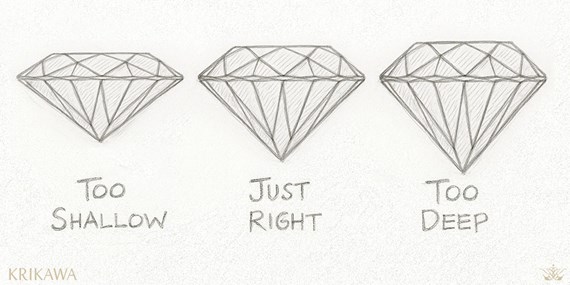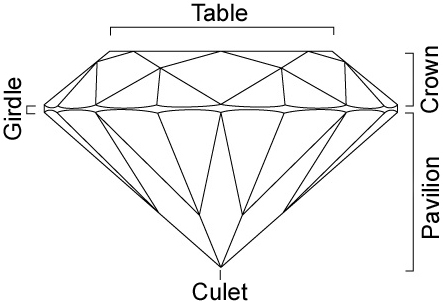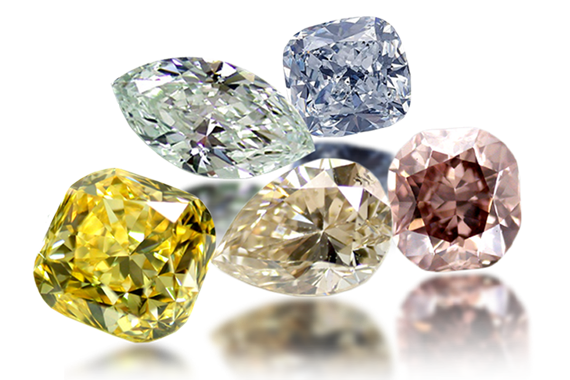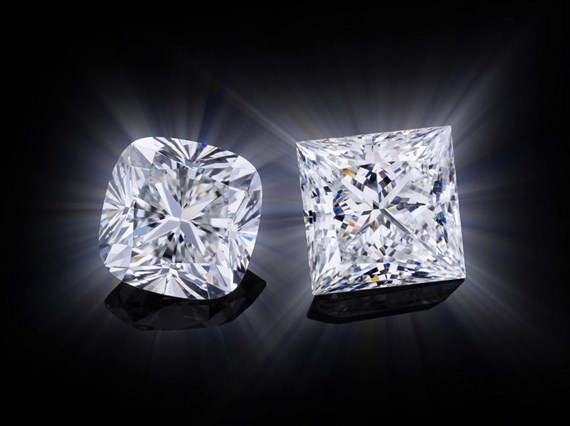The Four C’s of Diamond Grading

Cut, Color, Clarity, and Carat Weight
(Plus a Bonus Factor: Fluorescence)
You’ll often hear about the Four C’s of Diamonds when buying a diamond. These key characteristics define the quality of a finished stone and strongly influence its rarity and price:
- Cut – How well the diamond’s facets are proportioned and polished, creating brilliance and sparkle.
- Color – The degree to which a diamond is colorless, affecting brightness and value.
- Clarity – The presence (or absence) of internal inclusions and external blemishes.
- Carat Weight – The diamond’s weight contributes to size and rarity.
- Fluorescence – Though not a “C,” this measures a diamond’s glow under ultraviolet light and can subtly influence appearance.
A quick rule of thumb: rarity equals expense. The rarer a diamond’s combination of these factors, the more valuable the stone.
Cut: The Sparkle Factor

The only human-controlled element of a diamond’s beauty is its cut, meaning the stone's proportions, symmetry, and polish. Cut is not the same as shape. A well-cut diamond displays three dazzling effects:
Brilliance- Bright white light reflecting inside and out.
Fire- Flashes of rainbow color as light disperses through the diamond.
Scintillation- Sparkling pinpoints of light when the diamond or viewer moves.
A diamond that is too shallow or too deep will leak light and look dull. We recommend Very Good to Excellent cuts for maximum sparkle.
Do Different Ring Settings Affect Sparkle?
Yes. The way a diamond is set influences how light enters and reflects, which can subtly change its sparkle. Prong settings allow the most light for maximum brilliance, while bezel or flush settings offer more protection but slightly soften the shine. Halo or pavé designs can add extra shimmer by reflecting light from surrounding accent stones.
Diamond Anatomy

A faceted diamond has three main parts:
Crown - The top, including the large flat facet called the table.
Girdle - The thin edge that forms the setting boundary.
Pavilion - The lower portion, ending in a point or tiny facet called the culet.
Proper girdle thickness matters, too. Overly thin girdles can chip; overly thick girdles hide weight where you can’t see it.
Color: From Colorless to Fancy

Although diamonds are often considered colorless, most have subtle yellow or brown tints. Diamonds in the normal color range are graded D (colorless) through Z (light color).
| Grade | Description |
|---|---|
| D-F | Colorless- rarest and most valuable. |
| G-J | Near Colorless- looks white when set. |
| K-M | Faint Color. |
| N-R | Very Light Color. |
| S-Z | Light Color. |
Even tiny differences in grade can affect price. We recommend H or better for a diamond that looks white to the naked eye.
Diamonds can also display natural hues such as pink, blue, green, or yellow beyond Z on the scale. These fancy-colored diamonds become more valuable as their color deepens.
Learn More About Fancy Colored Diamonds→
Clarity: Nature’s Fingerprint

Almost every diamond contains inclusions (internal features) or blemishes (surface marks), determining its clarity grade.
| Grade | What It Means |
| FL / IF | Flawless or Internally Flawless – no inclusions visible under 10× magnification. |
| VVS1–VVS2 | Very, Very Slightly Included – minute inclusions are very hard to detect. |
| VS1–VS2 | Very Slightly Included – minor inclusions, difficult to see. |
| SI1–SI2 | Slightly Included – noticeable under magnification. |
| I1–I3 | Included – obvious inclusions. |
For best value and an “eye-clean” look, VS2–SI1 is an excellent range.
Carat Weight: Size and Rarity

A carat (ct) equals 0.2 grams and is divided into 100 “points.” Price rises steeply with weight because large diamonds are rarer. For example, a 1.00 ct diamond costs far more than twice the price of a 0.50 ct stone of the same quality.
Remember, carat measures weight, not visible size. Two diamonds of equal weight can look different depending on cut and setting.
Fluorescence: The Honorary "C” to Know

About 25% of diamonds glow, usually blue, when exposed to ultraviolet light, a component of daylight.
Fluorescence is graded from None to Very Strong. In most cases, it has little to no effect on beauty or durability. Still, strong fluorescence can sometimes make a diamond appear slightly hazy or, conversely, make a faint-colored diamond look whiter.
Think of fluorescence as the fifth factor, an honorary C that helps you choose the diamond that looks best in everyday light.
Here's more information about fluorescence from the experts: Understanding Fluorescence from GIA.
Other Grading Factors Professionals Consider
In addition to the Four C’s and fluorescence, professionals evaluate diamond polish and symmetry, which describe how precisely the facets are finished and aligned. They may look at cut proportions in more detail (table size, crown, and pavilion angles) and assess light performance with tools like hearts-and-arrows or Ideal-Scope images. Other considerations can include girdle thickness, culet size, and presence of strain or graining inside the crystal. These aspects refine the overall cut grade and can influence a diamond’s beauty, durability, and value.
